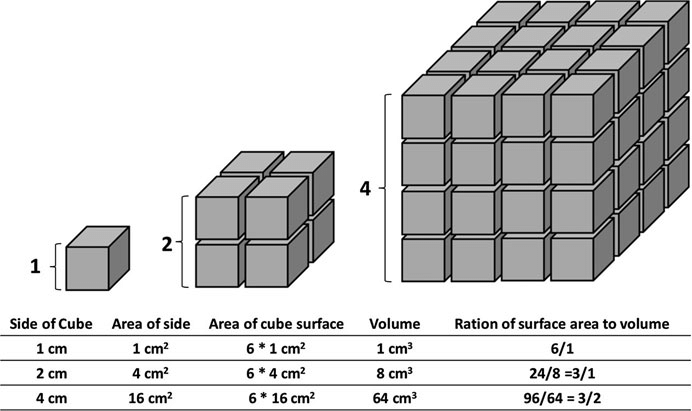Surface-to-Volume Ratio: The Key to Nanoscale Properties
What is Surface-to-Volume Ratio?
Surface-to-volume ratio is a fundamental concept in nanotechnology that describes the relationship between the surface area and volume of a material or object. As the size of a material decreases to the nanoscale, the surface-to-volume ratio increases dramatically, leading to unique properties and behaviors that differ from those of bulk materials.

Mathematical Representation
The surface-to-volume ratio can be expressed mathematically as:
Surface-to-Volume Ratio = Surface Area / Volume
For a cube with side length L, the surface area is 6L2, and the volume is L3. Thus, the surface-to-volume ratio for a cube is:
Surface-to-Volume Ratio (Cube) = 6L2 / L3 = 6/L
As the side length L decreases, the surface-to-volume ratio increases inversely proportionally. This relationship holds true for other shapes as well, with the specific mathematical expressions varying based on the geometry.
Significance in Nanotechnology
The high surface-to-volume ratio of nanomaterials has profound implications for their properties and applications:
Enhanced Reactivity
Nanomaterials with high surface-to-volume ratios have a large proportion of their atoms or molecules exposed at the surface. This exposure makes them more reactive and catalytically active compared to bulk materials. The increased reactivity is beneficial for applications such as catalysis, sensing, and drug delivery.
Improved Adsorption
The high surface area of nanomaterials enables them to adsorb large amounts of molecules or ions from their surroundings. This property is exploited in applications such as water purification, gas storage, and battery electrodes, where the adsorption capacity plays a crucial role.
Quantum Confinement Effects
As the size of a material approaches the nanoscale, quantum confinement effects become significant. The high surface-to-volume ratio of nanomaterials leads to the confinement of electrons, holes, or excitons within the nanoscale dimensions. This confinement results in unique optical, electronic, and magnetic properties that differ from those of bulk materials.
Mechanical Properties
The high surface-to-volume ratio of nanomaterials can also affect their mechanical properties. Nanomaterials often exhibit higher strength, hardness, and toughness compared to their bulk counterparts. This enhancement is attributed to the reduction in the number and size of defects, as well as the increased influence of surface atoms on the overall mechanical behavior.
Examples of High Surface-to-Volume Ratio Nanomaterials
Several nanomaterials are known for their exceptionally high surface-to-volume ratios:
Nanoparticles
Nanoparticles, such as gold nanoparticles, silver nanoparticles, and quantum dots, have a large proportion of their atoms at the surface. This high surface-to-volume ratio makes them ideal for catalysis, sensing, and biomedical applications.
Nanowires and Nanotubes
One-dimensional nanostructures, such as nanowires and nanotubes, have high surface-to-volume ratios due to their small diameters and large aspect ratios. These materials are used in electronics, energy storage, and sensing applications.
Porous Nanomaterials
Porous nanomaterials, such as metal-organic frameworks (MOFs) and mesoporous silica, have extremely high surface areas due to their nanoscale pores and channels. These materials are utilized in gas storage, separation, and catalysis applications.
Challenges and Considerations
While high surface-to-volume ratios offer numerous benefits, they also present challenges and considerations:
Stability
Nanomaterials with high surface-to-volume ratios can be prone to instability due to their increased reactivity. They may undergo undesirable reactions, such as oxidation or aggregation, which can affect their performance and shelf life. Strategies such as surface functionalization or encapsulation are often employed to improve their stability.
Toxicity
The high surface-to-volume ratio of nanomaterials can also raise concerns about their potential toxicity. The increased reactivity and small size of nanomaterials may lead to enhanced interactions with biological systems, potentially causing adverse effects. Thorough toxicological studies and safety assessments are crucial when developing and using nanomaterials.
Future Perspectives
The understanding and control of surface-to-volume ratio in nanomaterials will continue to drive advancements in nanotechnology. Future research will focus on the precise tuning of surface-to-volume ratios to optimize the properties and performance of nanomaterials for specific applications. The development of novel synthesis and fabrication techniques will enable the creation of nanomaterials with tailored surface-to-volume ratios, opening up new possibilities in fields such as energy, environment, healthcare, and electronics.
Further Reading
ACS Central Science, Surface-Area-to-Volume Ratio Determines Surface Tensions in Microscopic, Surfactant-Containing Droplets
Nanotechnology Reviews, Mechanical properties of nanomaterials: A review
Journal of Nanoparticle Research, Structural parameters of nanoparticles affecting their toxicity for biomedical applications: a review
